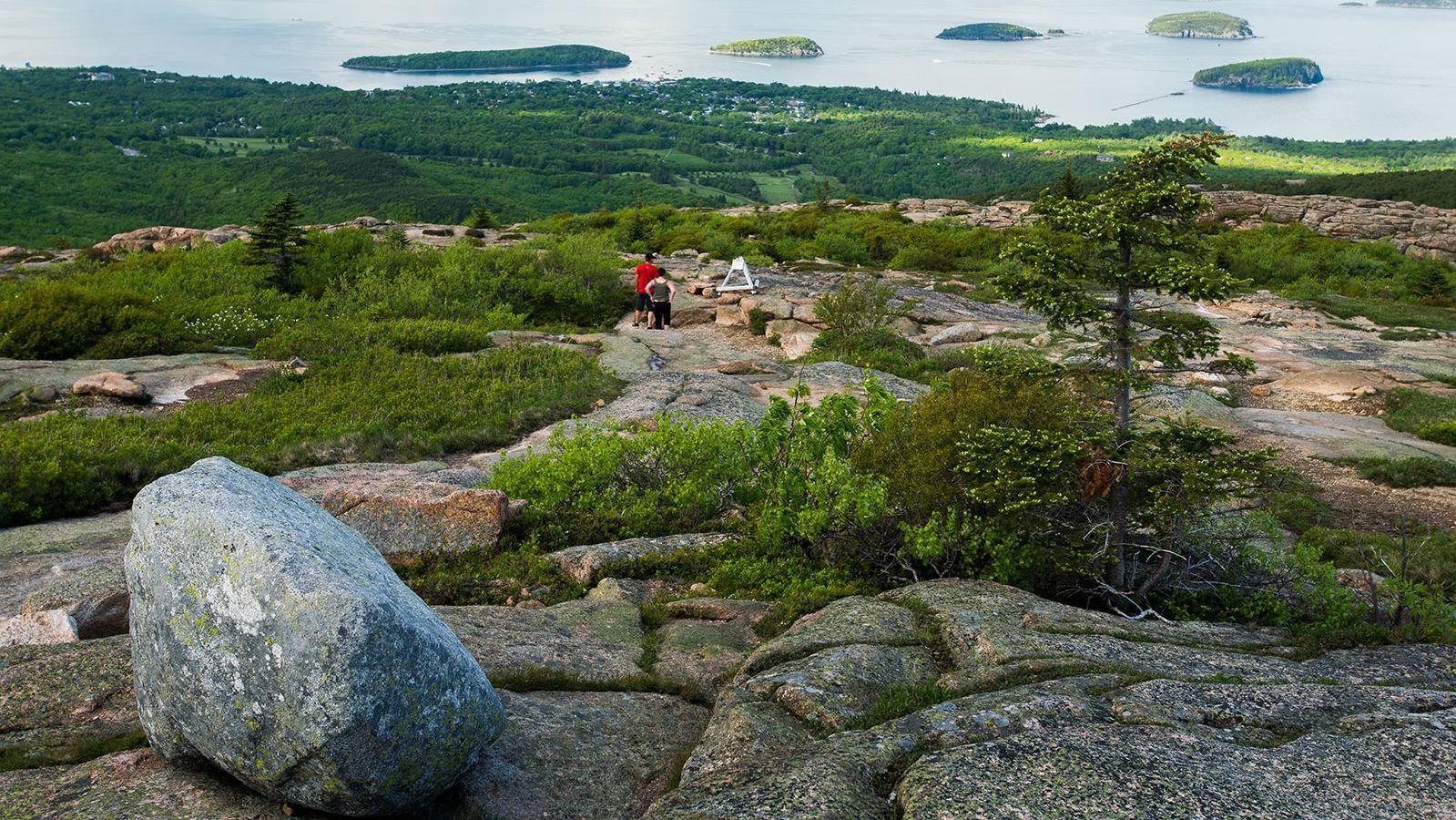Last updated: June 2, 2022
Place
Acadia Earthcache Course Stop Three: Jellybean Glacial Erratic

Kent Miller Photo. Used with permission.
Quick Facts
Location:
Cadillac Mountain, Summit Area
Significance:
Third Stop on the Acadia Earthcache Course
The third stop on the Acadia Earthcache Course is the Jellybean Glacial Erratic atop Cadillac Mountain (please note: you will need a vehicle reservation to visit the summit of Cadillac Mountain from mid-May to mid-October).
N 44° 21.122’
W 68° 13.428’
On a clear day, looking towards Bar Harbor you will see a group of islands known as the Porcupine Islands. On foggy days, you may need to refer to the exhibit above. The islands share a distinctive look caused by glacial plucking. As the ice sheet expanded from the north, the north sides of the islands and surrounding mountains were scoured by the glaciers, leaving gentle, polished slopes. The south sides experienced glacial plucking, which resulted in steep, irregular, and jagged slopes. Plucking occurs when ice melts due to increased pressure and the water under the glacier penetrates bedrock fractures. Subsequent freezing separates rocks from the bedrock and surrounds them in ice. Another terrific example of plucking may be seen from Sand Beach looking towards the mountain known as the Beehive, which you will be passing on the way to your next location.
Cadillac Mountain also provides close-up opportunities to see glacial impacts. Look in the direction of Bar Harbor and the Porcupines (use the exhibit if it’s foggy), and you will spot a nearby glacial erratic nicknamed “the Jellybean.” Like Bubble Rock, this erratic also came from the region of Lucerne, Maine, 30 miles away.
Please keep off the vegetation growing among the rocks; it is part of the fragile Cadillac Mountain ecosystem and is easily damaged by footsteps.
N 44° 1_.004’
W 68° 11.522’
N 44° 21.122’
W 68° 13.428’
Reading
You now stand on the tallest mountain on the Atlantic Coast of the United States. At 1,530 feet, Cadillac Mountain provides a bird’s-eye view of glacial impacts on the surrounding area.On a clear day, looking towards Bar Harbor you will see a group of islands known as the Porcupine Islands. On foggy days, you may need to refer to the exhibit above. The islands share a distinctive look caused by glacial plucking. As the ice sheet expanded from the north, the north sides of the islands and surrounding mountains were scoured by the glaciers, leaving gentle, polished slopes. The south sides experienced glacial plucking, which resulted in steep, irregular, and jagged slopes. Plucking occurs when ice melts due to increased pressure and the water under the glacier penetrates bedrock fractures. Subsequent freezing separates rocks from the bedrock and surrounds them in ice. Another terrific example of plucking may be seen from Sand Beach looking towards the mountain known as the Beehive, which you will be passing on the way to your next location.
Cadillac Mountain also provides close-up opportunities to see glacial impacts. Look in the direction of Bar Harbor and the Porcupines (use the exhibit if it’s foggy), and you will spot a nearby glacial erratic nicknamed “the Jellybean.” Like Bubble Rock, this erratic also came from the region of Lucerne, Maine, 30 miles away.
Please keep off the vegetation growing among the rocks; it is part of the fragile Cadillac Mountain ecosystem and is easily damaged by footsteps.
Next Clue
Count the number of islands labeled in the exhibit above. Subtract one. (Don’t include Mount Desert as one of the islands.) Place your answer in the space within the coordinates below to find your next location. To get to the next clue, stay on Park Loop Road.N 44° 1_.004’
W 68° 11.522’
